Numerical Investigation on Detonation Initiation and Propagation with a Symmetric-Jet in Supersonic Combustible Gas
Abstract
:1. Introduction
2. Computational Model
2.1. Computational Setup
2.2. Governing Equations and Numerical Methods
2.3. Mesh Refinement Verification
3. Results and Discussions
3.1. Analysis of the Detonation Induced by a Single-Jet
3.2. Analysis of the Detonation Induced by Symmetric-Jet
3.3. Effects of Diameter of Hot Jet Dj on Detonation Initiation
4. Conclusions
- (1)
- The symmetric hot jets significantly change the process of detonation initiation. The jet-induced bow shocks interact with each other forming a local detonation. This new flow field structure also makes the interaction of the shear layer behind the triple points form a periodic shedding vortex structure, which enhances the diffusion effect in the unburned region.
- (2)
- Compared to a single-jet, using a symmetric-jet (with a diameter of 4 mm) can significantly reduce the distance to complete initiation (by about 52%). The symmetric- jet initiation method helps to reduce the length of the combustion chamber and facilitates the lightweight design of the engine.
- (3)
- In the action of the propagation of the triple points, the development process of detonation combustion is more rapid when using a symmetric-jet. In addition, the detonation wave formation by a single-jet exhibits single-headed self-sustaining propagation, while the symmetric-jet condition exhibits double-headed self-sustaining propagation. However, neither operating condition has significant effect on the degree of detonation overdrive.
- (4)
- The jet strength has a significant effect on the process of symmetric-jet initiation. In this study, when the jet diameter decreases to 2.5 mm, the local detonation relies on the two Mach reflections formed on the wall to produce a second collision at the intersection. Thus, the wall boundary condition of the engine combustion chamber needs to be considered at this time. This also leads to a longer time to complete initiation relative to the single-jet approach.
Author Contributions
Funding
Conflicts of Interest
References
- Kireeti, S.K.; Ravikiran Sastry, G.; Gugulothu, S.K.; Deepanraj, B.; Loke Show, P.; Xia, A.; Arthi, M. Numerical investigations on the implication of hydrogen fuel jet injection pressure on the performance characteristics in a multi-strut in a double-dual cavity-based scramjet combustor. Fuel 2022, 324, 124528. [Google Scholar] [CrossRef]
- Sharma, V.; Eswaran, V.; Chakraborty, D. Determination of optimal spacing between transverse jets in a scramjet engine. Aerosp. Sci. Technol. 2020, 96, 105520. [Google Scholar] [CrossRef]
- Wolański, P. Detonative propulsion. Proc. Combust. Inst. 2013, 34, 125–158. [Google Scholar] [CrossRef]
- Tunik, Y.V.; Mayorov, V.O. Busemann diffuser for supersonic ramjet engine with detonation combustion of hydrogen-air mixture. Int. J. Hydrogen Energ. 2022, 47, 21828–21840. [Google Scholar] [CrossRef]
- Phylippov, Y.G.; Dushin, V.R.; Nikitin, V.F.; Nerchenko, V.A.; Korolkova, N.V.; Guendugov, V.M. Fluid mechanics of pulse detonation thrusters. Acta Astronaut. 2012, 76, 115–126. [Google Scholar] [CrossRef]
- Wang, G.; Liu, S.; Peng, H.; Liu, W. Experimental Investigation of a Cylindrical Air-Breathing Continuous Rotating Detonation Engine with Different Nozzle Throat Diameters. Aerospace 2022, 9, 267. [Google Scholar] [CrossRef]
- Yan, C.; Teng, H.H.; Mi, X.C.; Ng, H.D. The Effect of Chemical Reactivity on the Formation of Gaseous Oblique Detonation Waves. Aerospace 2019, 6, 62. [Google Scholar] [CrossRef]
- Li, C.; Kailasanath, K. Detonation initiation by Annular-Jet-Induced imploding shocks. J. Propul. Power 2005, 21, 183–186. [Google Scholar] [CrossRef]
- Liang, J.; Cai, X.; Lin, Z.; Deiterding, R. Effects of a hot jet on detonation initiation and propagation in supersonic combustible mixtures. Acta Astronaut. 2014, 105, 265–277. [Google Scholar] [CrossRef]
- Gordon, P.V.; Kagan, L.; Sivashinsky, G. Parametric transition from deflagration to detonation revisited: Planar geometry. Combust. Flame 2020, 211, 465–476. [Google Scholar] [CrossRef]
- Knystautas, R.; Lee, J.H.; Moen, I.; Wagner, H.G. Direct Initiation of Spherical Detonation by a Hot Turbulent Gas Jet. Symp. (Int.) Combust. 1979, 17, 1235–1245. [Google Scholar] [CrossRef]
- Ishii, K.; Kataoka, H.; Kojima, T. Initiation and propagation of detonation waves in combustible high speed flows. Proc. Combust. Inst. 2009, 32, 2323–2330. [Google Scholar] [CrossRef]
- Han, X.; Zhou, J.; Lin, Z. Experimental investigations of detonation initiation by hot jets in supersonic premixed flows. Chin. Phys. B 2012, 21, 309–313. [Google Scholar] [CrossRef]
- Chen, W.; Liang, J.; Cai, X.; Lin, Z. The initiation and propagation of detonation in supersonic combustible flow with boundary layer. Int. J. Hydrogen Energ. 2018, 43, 12460–12472. [Google Scholar] [CrossRef]
- Cirak, F.; Deiterding, R.; Mauch, S.P. Large-scale fluid-structure interaction simulation of viscoplastic and fracturing thin-shells subjected to shocks and detonations. Comput. Struct. 2007, 85, 1049–1065. [Google Scholar] [CrossRef]
- Deiterding, R. A parallel adaptive method for simulating shock-induced combustion with detailed chemical kinetics in complex domains. Comput. Struct. 2009, 87, 769–783. [Google Scholar] [CrossRef]
- Cai, X.; Liang, J.; Deiterding, R.; Lin, Z. Numerical Investigation on Detonation Control Using a Pulse Hot Jet in Supersonic Combustible Mixture. Combust. Sci. Technol. 2016, 188, 1674–1690. [Google Scholar] [CrossRef]
- Peng, H.; Huang, Y.; Deiterding, R.; Luan, Z.; Xing, F.; You, Y. Effects of jet in crossflow on flame acceleration and deflagration to detonation transition in methane–oxygen mixture. Combust. Flame 2018, 198, 69–80. [Google Scholar] [CrossRef]
- Peng, H.; Huang, Y.; Deiterding, R.; You, Y.; Luan, Z. Effects of Transverse Jet Parameters on Flame Propagation and Detonation Transition in Hydrogen-Oxygen-Argon Mixture. Combust. Sci. Technol. 2021, 193, 1516–1537. [Google Scholar] [CrossRef]
- Bulat, M.P.; Bulat, P.V.; Denissenko, P.V.; Esakov, I.I.; Grachev, L.P.; Volkov, K.N.; Volobuev, I.A. Ignition of lean and stoichiometric air–propane mixture with a subcritical microwave streamer discharge. Acta Astronaut. 2017, 150, 153–161. [Google Scholar] [CrossRef] [Green Version]
- Wang, Z.; Pan, Z.; Huang, J.; Wei, L.; Wang, Y.; Wang, Y. Effects of double-jet positions on detonation initiation characteristics. Aerosp. Sci. Technol. 2020, 97, 105609. [Google Scholar] [CrossRef]
- Mazaheri, K.; Mahmoudi, Y.; Sabzpooshani, M.; Radulescu, M.I. Experimental and numerical investigation of propagation mechanism of gaseous detonations in channels with porous walls. Combust. Flame 2015, 162, 2638–2659. [Google Scholar] [CrossRef]
- Mahmoudi, Y.; Mazaheri, K. High resolution numerical simulation of triple point collision and origin of unburned gas pockets in turbulent detonations. Acta Astronaut. 2015, 115, 40–51. [Google Scholar] [CrossRef]
- Miao, S.; Zhou, J.; Liu, S.; Cai, X. Formation mechanisms and characteristics of transition patterns in oblique detonations. Acta Astronaut. 2018, 142, 121–129. [Google Scholar] [CrossRef]
- Yuan, X.; Zhou, J.; Liu, S.; Lin, Z. Diffraction of cellular detonation wave over a cylindrical convex wall. Acta Astronaut. 2019, 169, 94–107. [Google Scholar] [CrossRef]
- Strehlow, R.A. Gas pase detonations: Recent developments. Combust. Flame 1968, 12, 81–101. [Google Scholar] [CrossRef]
- Pintgen, F.; Eckett, C.A.; Austin, J.M.; Shepherd, J.E. Direct observations of reaction zone structure in propagating detonations. Combust. Flame 2003, 133, 211–229. [Google Scholar] [CrossRef]
- Gorbatenko, I.; Bradley, D.; Tomlin, A.S. Auto-ignition and detonation of n-butanol and toluene reference fuel blends (TRF). Combust. Flame 2021, 229, 111378. [Google Scholar] [CrossRef]
- Dai, J.; Xu, F.; Cai, X.; Mahmoudi, Y. Effects of velocity shear layer on detonation propagation in a supersonic expanding combustor. Phys. Fluids 2021, 33, 105110. [Google Scholar] [CrossRef]
- Bakalis, G.; Tang-Yuk, K.C.; Mi, X.; Nikiforakis, N.; Ng, H.D. Numerical simulation of deflagration-to-detonation transition via shock–multiple flame kernels interactions. Comput. Math. Appl. 2020, 83, 111–126. [Google Scholar] [CrossRef]
- Ziegler, J.L.; Deiterding, R.; Shepherd, J.E.; Pullin, D.I. An adaptive high-order hybrid scheme for compressive, viscous flows with detailed chemistry. J. Comput. Phys. 2011, 230, 7598–7630. [Google Scholar] [CrossRef]
- Chen, W.; Liang, J.; Cai, X.; Mahmoudi, Y. Three-dimensional Simulations of Detonation Propagation in Circular Tubes: Effects of Jet Initiation and Wall Reflection. Phys. Fluids 2020, 32, 046104. [Google Scholar]
- Varatharajan, B.; Williams, F.A. Chemical-kinetic descriptions of high-temperature ignition and detonation of acetylene-oxygen-diluent systems. Combust. Flame 2001, 124, 624–645. [Google Scholar] [CrossRef]
- Liu, X.; Chen, Y.; Xia, Z.; Wang, J. Numerical study of the reverse-rotating waves in rotating detonation engine with a hollow combustor. Acta Astronaut. 2020, 170, 421–430. [Google Scholar] [CrossRef]
- Ng, H.D. Effects of activation energy on the instability of oblique detonation surfaces with a one-step chemistry model. Phys. Fluids 2018, 30, 106110. [Google Scholar] [CrossRef]
- Sharpe, G.J.; Radulescu, M.I. Statistical analysis of cellular detonation dynamics from numerical simulations: One-step chemistry. Combust. Theor. Model. 2011, 15, 691–723. [Google Scholar] [CrossRef]
- Lappa, M. A mathematical and numerical framework for the analysis of compressible thermal convection in gases at very high temperatures. J. Comput. Phys. 2016, 313, 687–712. [Google Scholar] [CrossRef]
- Zhang, Y.; Deng, W.; Zhu, J. A new sixth-order finite difference WENO scheme for fractional differential equations. J. Sci. Comput. 2021, 87, 73. [Google Scholar] [CrossRef]
- Ketcheson, D.I. Highly efficient strong stability preserving Runge-Kutta methods with Low-Storage Implementations. SIAM J. Sci. Comput. 2008, 30, 2113–2136. [Google Scholar] [CrossRef]
- Kaps, P.; Rentrop, P. Generalized Runge-Kutta methods of order four with stepsize control for stiff ordinary differential equations. Numer. Math. 1979, 33, 55–68. [Google Scholar] [CrossRef]
- Deiterding, R.; Bader, G. High-Resolution Simulation of Detonations with Detailed Chemistry; Springer: Berlin/Heidelberg, Germany, 2005; pp. 69–91. [Google Scholar]
- Cai, X.; Liang, J.; Lin, Z.; Deiterding, R.; Liu, Y. Parametric study of detonation initiation using a hot jet in supersonic combustible mixtures. Aerosp. Sci. Technol. 2014, 39, 442–455. [Google Scholar] [CrossRef]
- Peng, N.; Yang, Y.; Wu, J.; Xiao, Z. Mechanism and modelling of the secondary baroclinic vorticity in the Richtmyer–Meshkov instability. J. Fluid Mech. 2021, 911, A56. [Google Scholar] [CrossRef]
- Rothstein, A.; Wantuck, P. A study of the normal injection of hydrogen into a heated supersonicflow using planar laser-induced fluorescence. In Proceedings of the 28th Joint Propulsion Conference and Exhibit, Nashville, TN, USA, 6–8 July 1992. [Google Scholar]
- Ben-Yakar, A.; Mungal, M.G.; Hanson, R.K. Time evolution and mixing characteristics of hydrogen and ethylene transverse jets in supersonic crossflows. Phys. Fluids 2006, 18, 26101. [Google Scholar] [CrossRef] [Green Version]

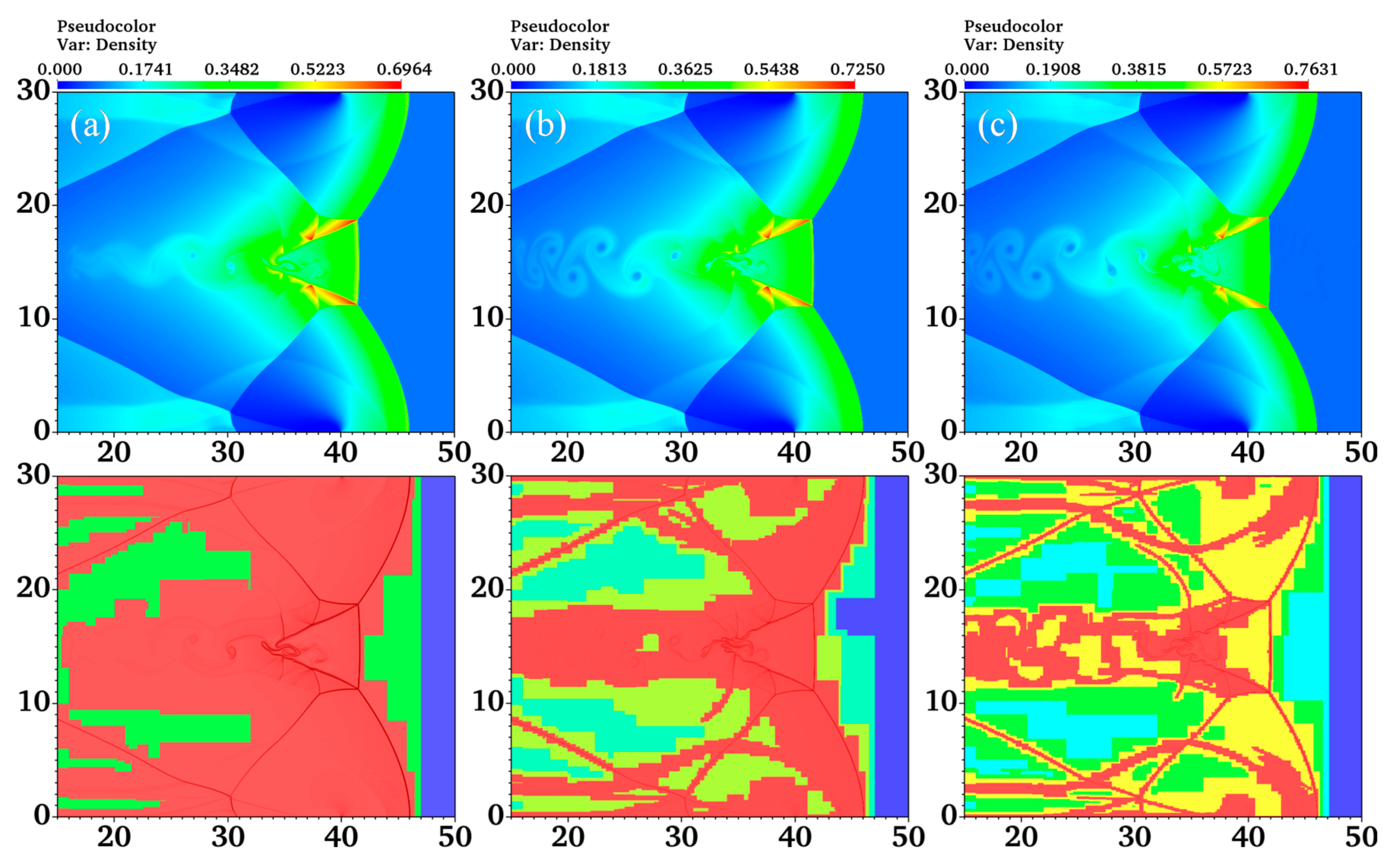
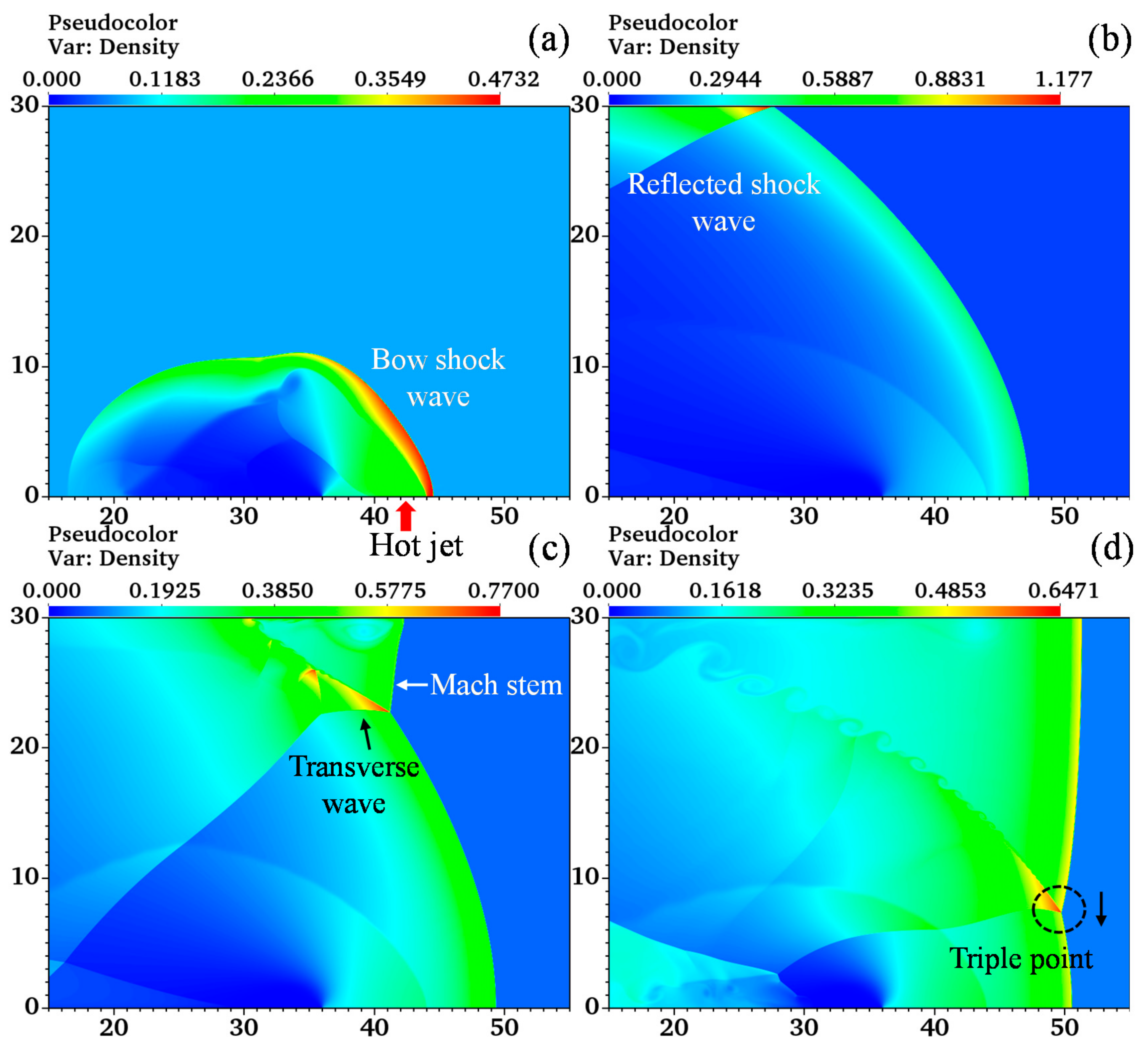
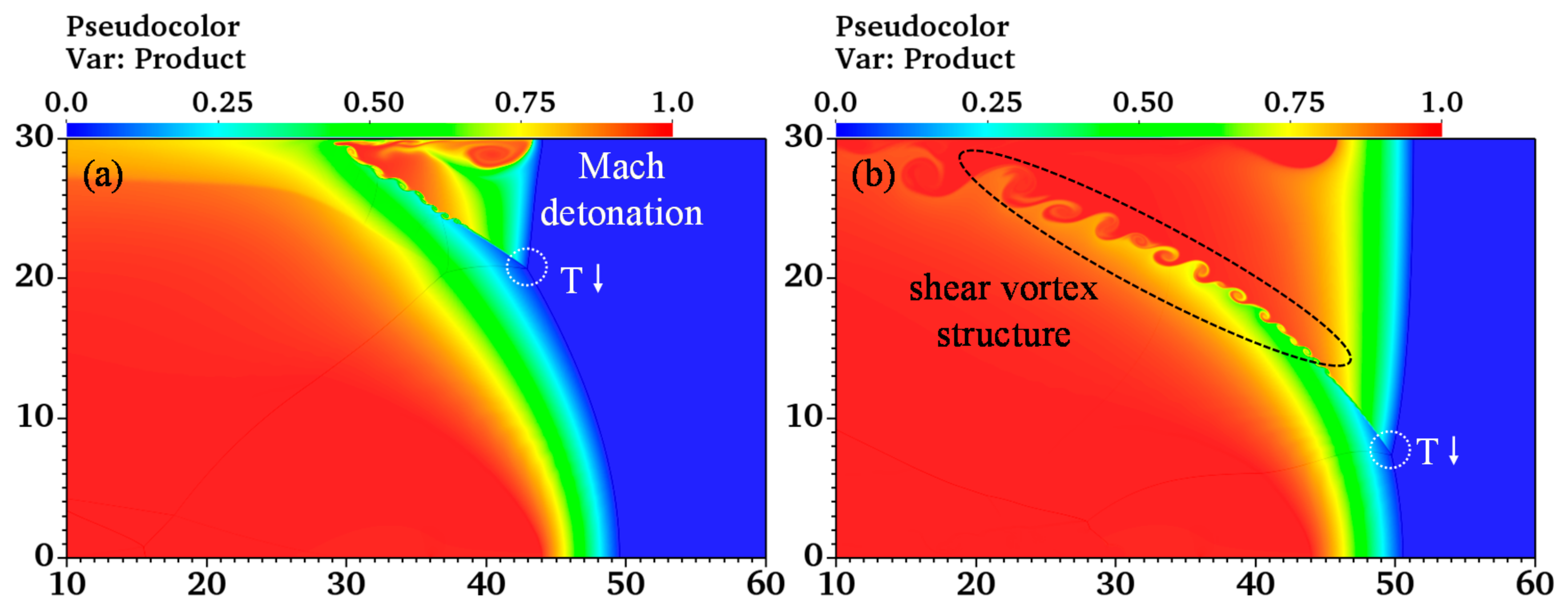
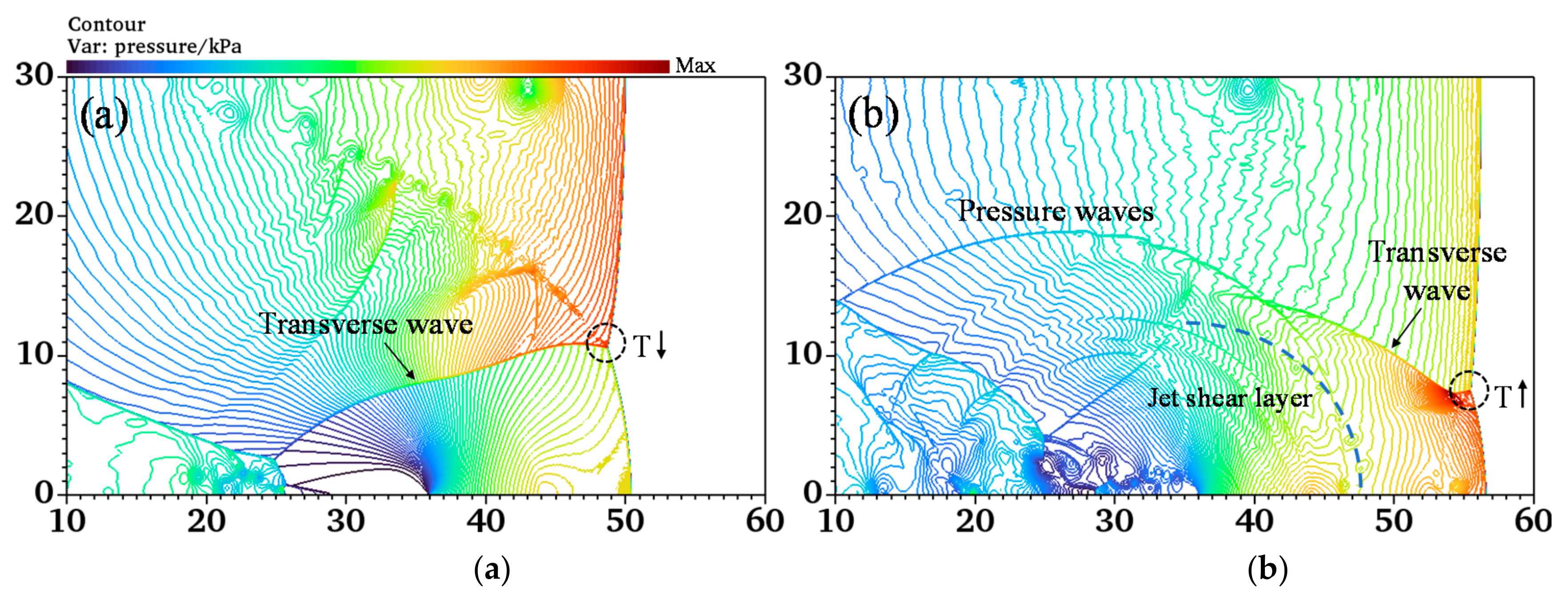
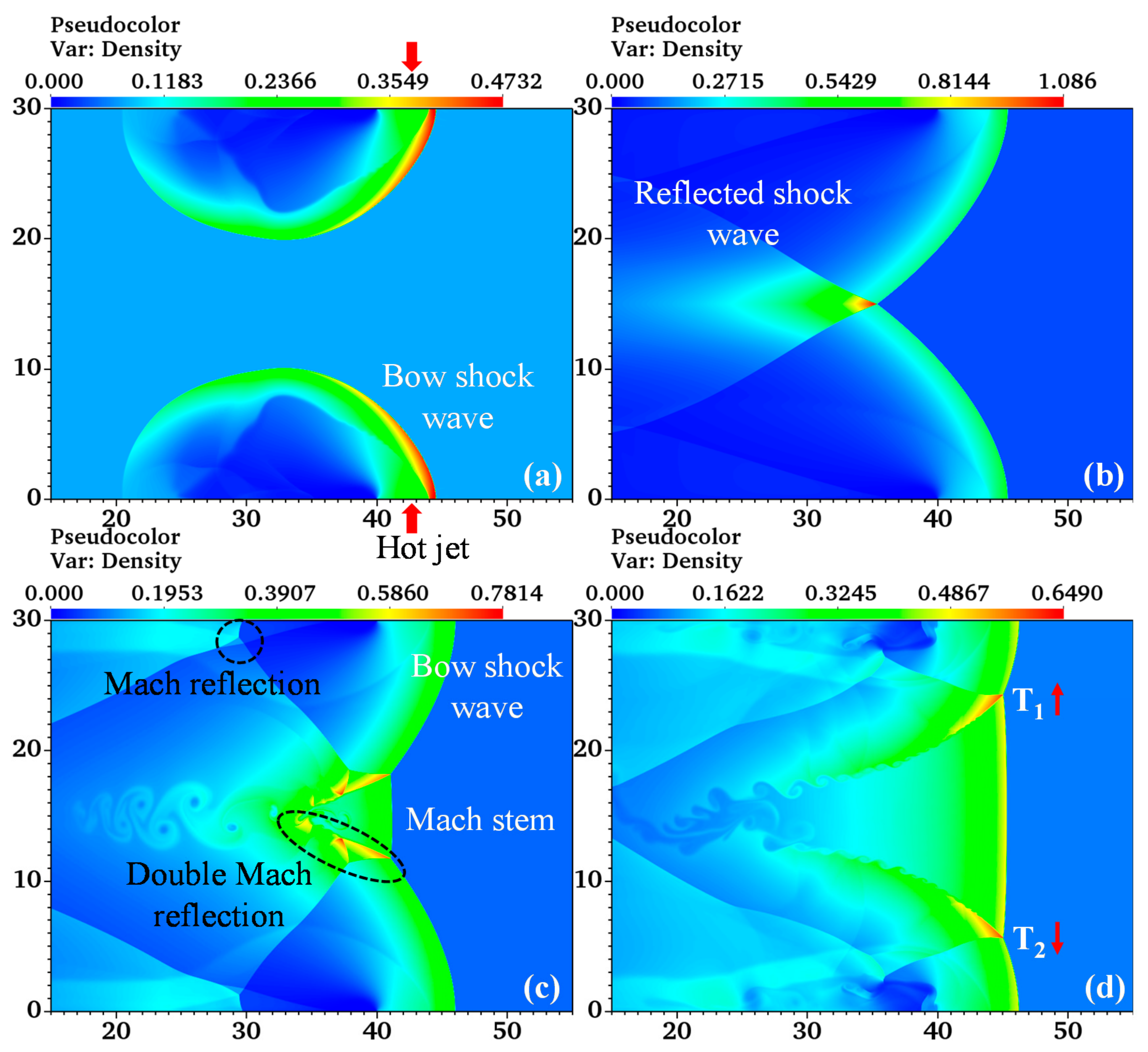


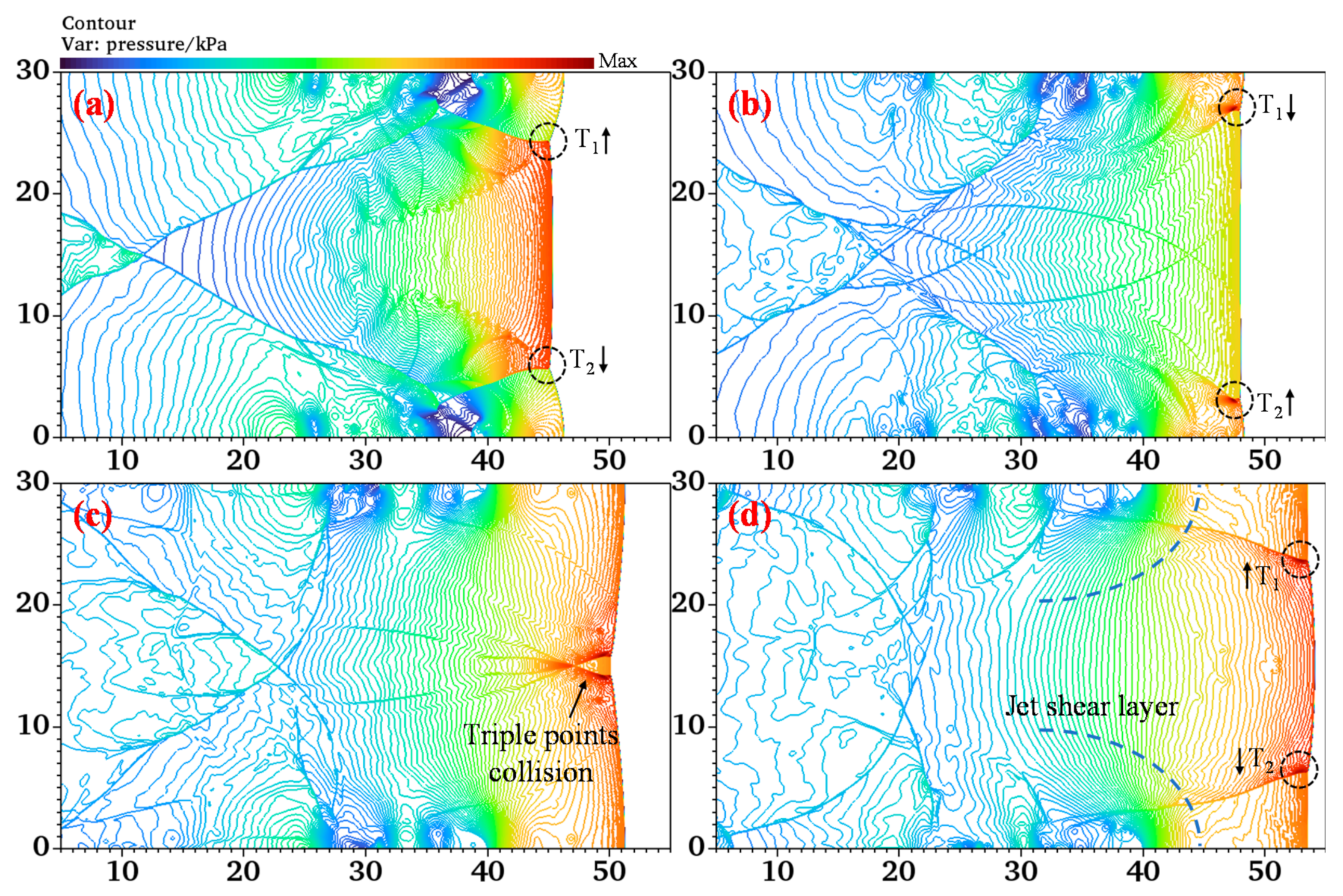
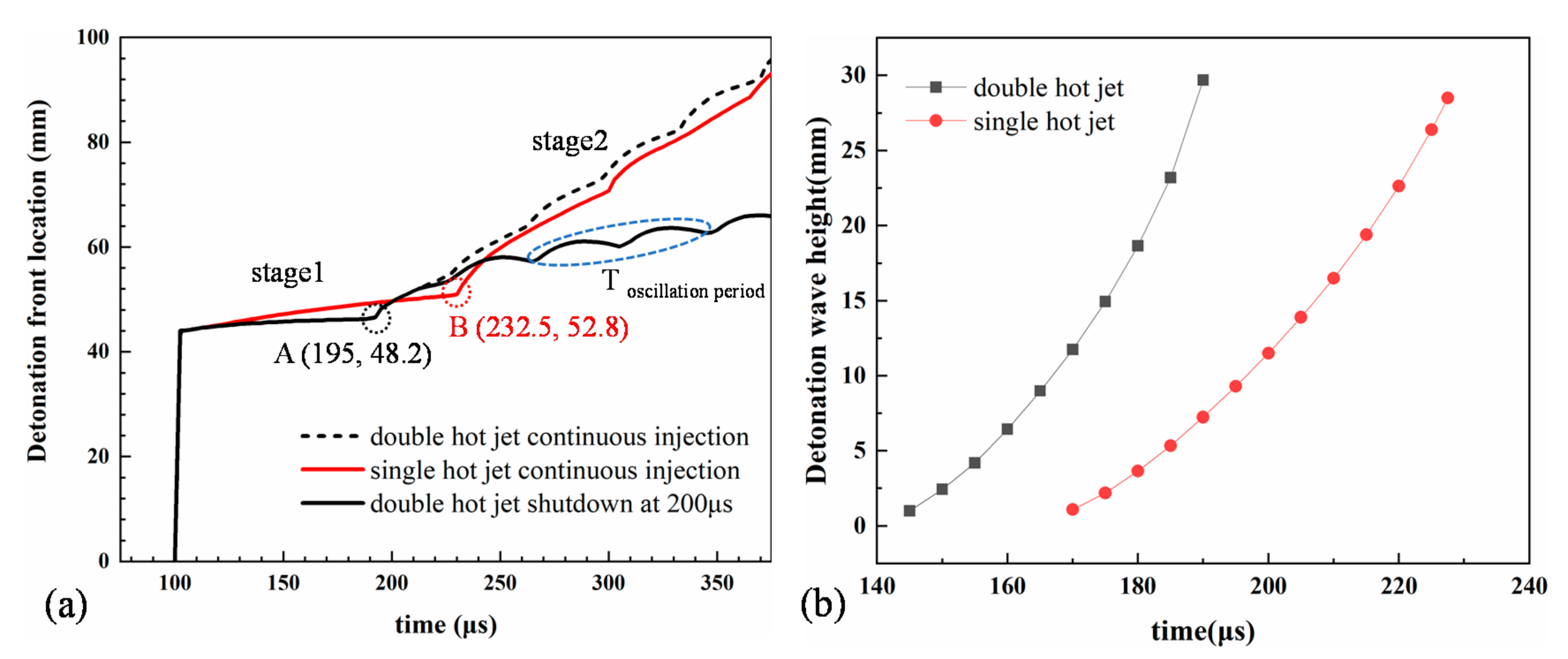
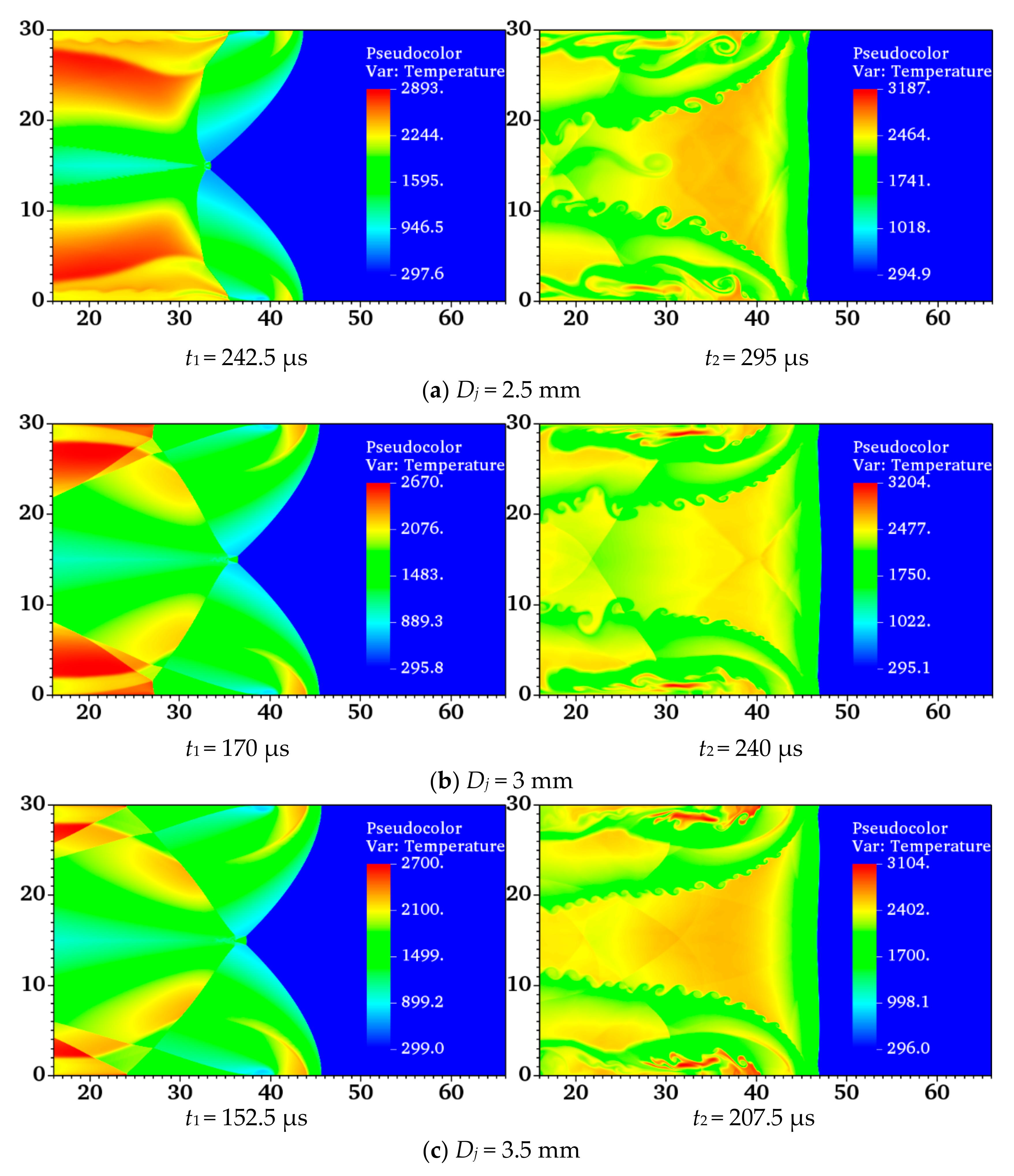
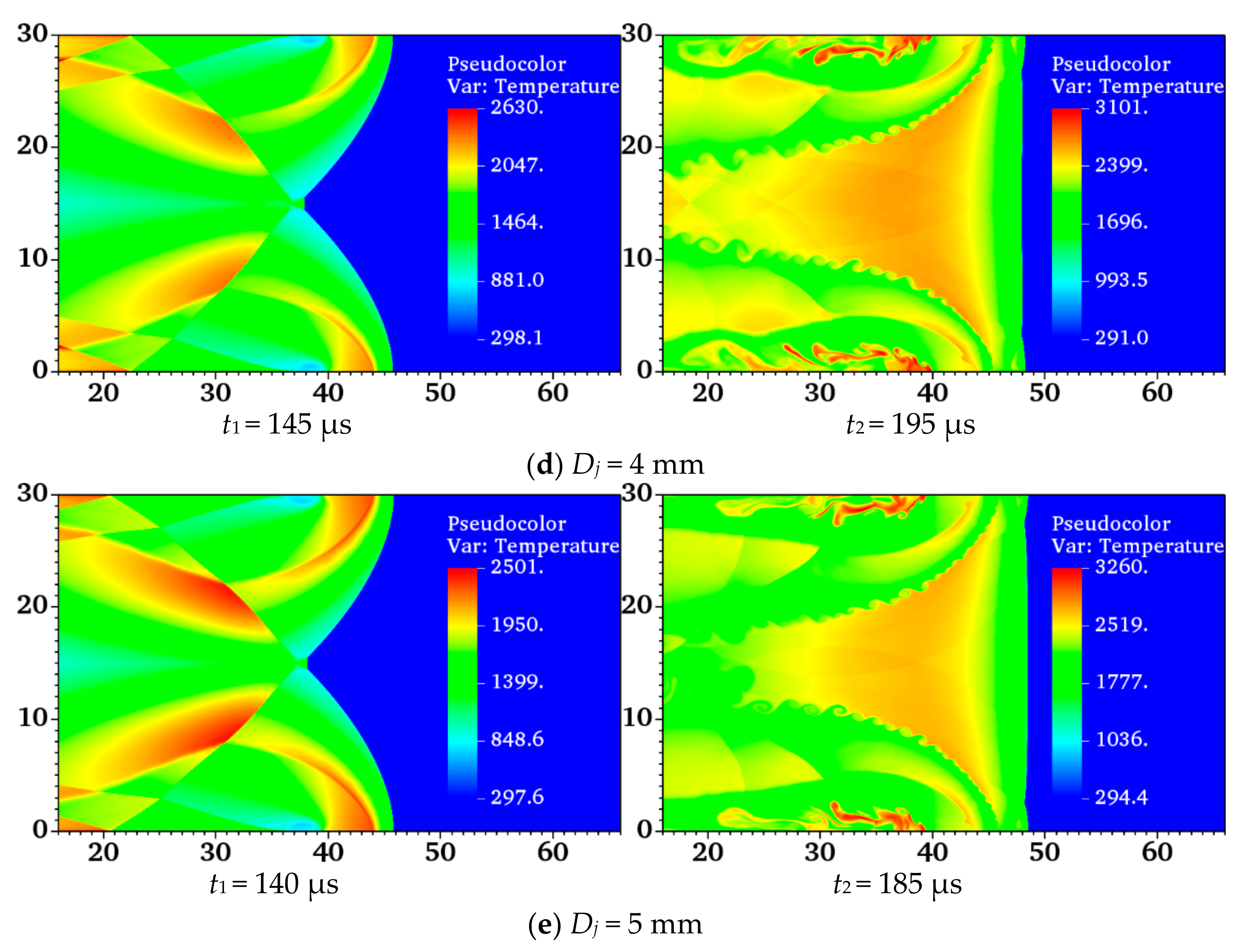
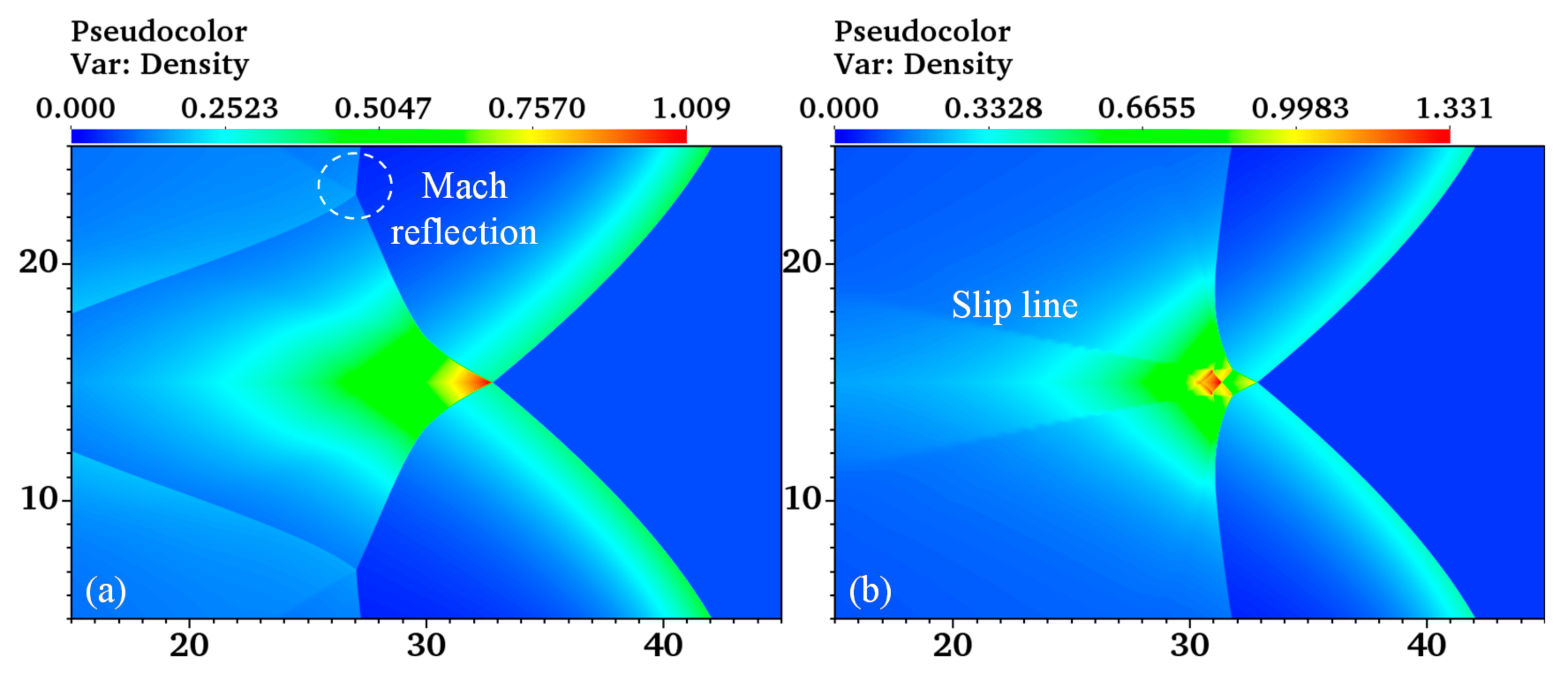

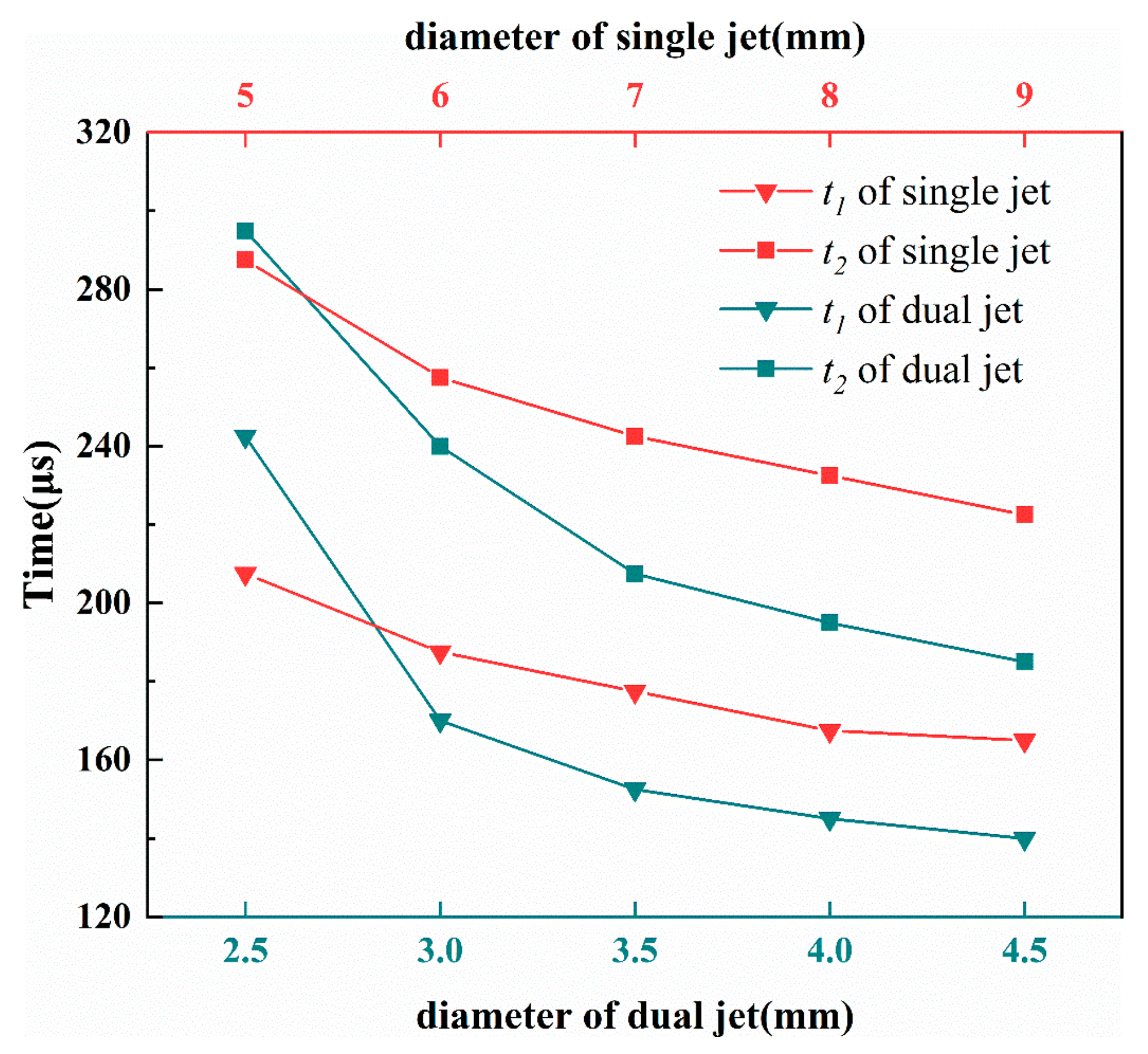
| Parameters | Values | Unit |
|---|---|---|
| 6.67 | kPa | |
| 300 | K | |
| 0.077552 | kg/m3 | |
| 1587.84 (CJ detonation velocity) | m/s | |
| Specific heat ratio of the mixed gas, | 1.29499 | - |
| Molecular quantity, | 0.029 | kg/mol |
| Heat release per unit mass, | 54,000 | J/mol |
| Activation energy, | 30,000 | J/mol |
| Frequency factor, | 6×105 | s−1 |
| Molar gas constant of the chemical reaction, | 8.314 | - |
| Parameters | Values | Unit |
|---|---|---|
| 86.376 | kPa | |
| 1943.8 | K | |
| 0.155 | kg/m3 | |
| 850 (speed of sound) | m/s | |
| Total energy per unit mass, | 349,280 | J/mol |
| Mass fraction of reactant, | 0.0088 | - |
| Mass fraction of product, | 0.9912 | - |
| Three-Level | Four-Level | Five-Level | |
|---|---|---|---|
| Refinement factors | (2, 2) | (2, 2, 2) | (2, 2, 2, 2) |
| Δmin | 3.125 × 10−5 m | 1.5625 × 10−5 m | 7.8125 × 10−6 m |
| Resolution | 68.64 Pts/Lhr | 137.28 Pts/Lhr | 274.56 Pts/Lhr |
| 2.5 | 3 | 3.5 | 4 | 4.5 | |
|---|---|---|---|---|---|
| 0.5727 | 0.5727 | 0.5727 | 0.5727 | 0.5727 | |
| (mm) | 4.5028 | 5.1335 | 5.7352 | 6.3131 | 6.8710 |
| 2.5 | 3 | 3.5 | 4 | 4.5 | |
|---|---|---|---|---|---|
| x (mm) | 33.47 | 36.20 | 37.15 | 37.86 | 38.06 |
| t1 (μs) | 242.5 | 170 | 152.5 | 145 | 140 |
| t2 (μs) | 295 | 240 | 207.5 | 195 | 185 |
| V (m/s) | |||
|---|---|---|---|
| 2.5 | 213.75 | 1801.59 | 1.287 |
| 3.0 | 237.87 | 1820.19 | 1.322 |
| 3.5 | 249.74 | 1836.64 | 1.339 |
| 4.0 | 266.02 | 1853.48 | 1.363 |
| 4.5 | 279.05 | 1866.50 | 1.382 |
Publisher’s Note: MDPI stays neutral with regard to jurisdictional claims in published maps and institutional affiliations. |
© 2022 by the authors. Licensee MDPI, Basel, Switzerland. This article is an open access article distributed under the terms and conditions of the Creative Commons Attribution (CC BY) license (https://creativecommons.org/licenses/by/4.0/).
Share and Cite
Dai, J.; Peng, L. Numerical Investigation on Detonation Initiation and Propagation with a Symmetric-Jet in Supersonic Combustible Gas. Aerospace 2022, 9, 501. https://doi.org/10.3390/aerospace9090501
Dai J, Peng L. Numerical Investigation on Detonation Initiation and Propagation with a Symmetric-Jet in Supersonic Combustible Gas. Aerospace. 2022; 9(9):501. https://doi.org/10.3390/aerospace9090501
Chicago/Turabian StyleDai, Jian, and Linyuan Peng. 2022. "Numerical Investigation on Detonation Initiation and Propagation with a Symmetric-Jet in Supersonic Combustible Gas" Aerospace 9, no. 9: 501. https://doi.org/10.3390/aerospace9090501
APA StyleDai, J., & Peng, L. (2022). Numerical Investigation on Detonation Initiation and Propagation with a Symmetric-Jet in Supersonic Combustible Gas. Aerospace, 9(9), 501. https://doi.org/10.3390/aerospace9090501






